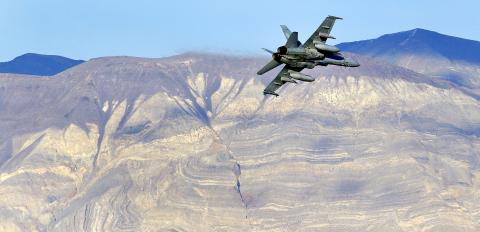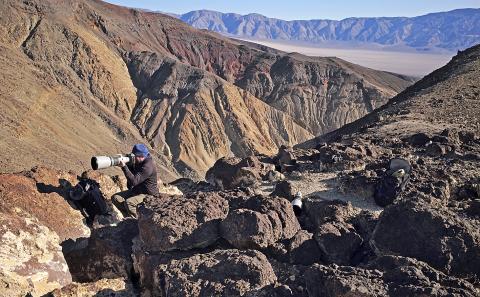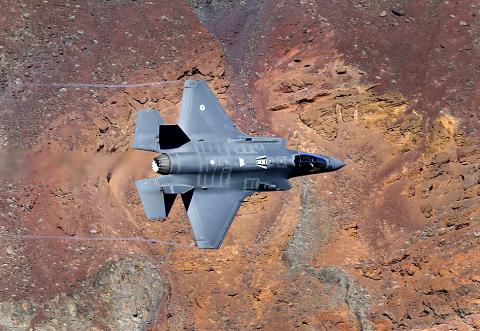Silence and stillness settled over the deep, sunbaked gorge as a pair of photographers sat on a cliff, waiting.
Then the rumbling started. As it grew louder, they scrambled into position.
Within seconds, a thunderous roar reverberated from the steep, narrow canyon as an F-18 fighter jet streaked through it, passing beneath their feet. It came so close they could see the pilots’ expressions.

Photo: Ben Margot, AP
This deafening show that was over in a flash is a fairly common sight at Death Valley National Park, 415 kilometers east of Los Angeles, where US and foreign militaries train pilots and test jets in the gorge nicknamed Star Wars Canyon.
Photographers — some capturing images for work, others for fun — along with aviation enthusiasts and others have been traipsing to the remote 12,142 square-kilometer park in growing numbers to see the jets soaring below the rim of what’s officially called Rainbow Canyon, near the park’s western entrance.
It earned its nickname because its mineral-rich soil and rocky walls in shades of red, gray and pink draw to mind a landscape in a galaxy far, far away — Tatooine, the home planet of Star Wars character Luke Skywalker.

Photo: Ben Margot, AP
The unusually close-up view of military planes zooming through the craggy gorge has become so popular the National Park Service is considering making it an attraction, with informational signs about the training that dates back to World War II.
Park Service officials recently discussed erecting signs and possibly paving a spot for cars because so many people are driving to the canyon to see the training, park spokeswoman Abby Wines said.
Wines understands the rush people get from seeing the jets up close. Once she was doing technical canyoneering, hanging from a rope on a 55-meter vertical, when a jet roared over her head but below the canyon rim.

Photo: Ben Margot, AP
“It’s the loudest thing I have ever heard in my life, “she said.“It was a scary experience since I was holding onto the rope and not anything else.” She also felt a sense of awe.
But on days when one jet passes after another, the noise gets to her.
Elsewhere in the park, the jets also have made it tough when performing the living history show at Scotty’s Castle, a Spanish mission-style villa reflecting early California architecture. The villa recently closed until further notice because of flood damage. But when it was open, it was “disruptive to act like it is 1939 while two military jets are circling, pretending to be in a dogfight above your head,” Wines said.
On a February day, planes careened through Star Wars Canyon 18 times. One pilot performed barrel rolls over the pass.
Jets zip through the gorge at 322 to 483 kph and can fly as low as 60 meters from the canyon floor. But the canyon’s walls are so steep, the aircraft are still several hundred feet below the rim. Training at the canyon doesn’t happen every day, so the photographers who make the trek to see them sometimes sit in folding chairs, waiting in the heat, and spy no jets at all.
Jason Watson, who works in information technology at Stanford University’s law school and does freelance photography, recently made his seventh trip to the gorge.
He’s seen as many as 30 photographers spread out across the mile-long rim at different vantage points.
“You can meet anyone from anywhere in the world there,” Watson said.
The photographers develop a comradery as they share in the thrill of standing above the speedy jets.
The aviators interact with them too, giving a thumbs-up or even flashing a “Hi Mom” sign as they whiz by.
“They know the photographers are there,” Watson said. “They’re aware of the following.”

April 14 to April 20 In March 1947, Sising Katadrepan urged the government to drop the “high mountain people” (高山族) designation for Indigenous Taiwanese and refer to them as “Taiwan people” (台灣族). He considered the term derogatory, arguing that it made them sound like animals. The Taiwan Provincial Government agreed to stop using the term, stating that Indigenous Taiwanese suffered all sorts of discrimination and oppression under the Japanese and were forced to live in the mountains as outsiders to society. Now, under the new regime, they would be seen as equals, thus they should be henceforth

Last week, the the National Immigration Agency (NIA) told the legislature that more than 10,000 naturalized Taiwanese citizens from the People’s Republic of China (PRC) risked having their citizenship revoked if they failed to provide proof that they had renounced their Chinese household registration within the next three months. Renunciation is required under the Act Governing Relations Between the People of the Taiwan Area and the Mainland Area (臺灣地區與大陸地區人民關係條例), as amended in 2004, though it was only a legal requirement after 2000. Prior to that, it had been only an administrative requirement since the Nationality Act (國籍法) was established in

With over 80 works on display, this is Louise Bourgeois’ first solo show in Taiwan. Visitors are invited to traverse her world of love and hate, vengeance and acceptance, trauma and reconciliation. Dominating the entrance, the nine-foot-tall Crouching Spider (2003) greets visitors. The creature looms behind the glass facade, symbolic protector and gatekeeper to the intimate journey ahead. Bourgeois, best known for her giant spider sculptures, is one of the most influential artist of the twentieth century. Blending vulnerability and defiance through themes of sexuality, trauma and identity, her work reshaped the landscape of contemporary art with fearless honesty. “People are influenced by

Three big changes have transformed the landscape of Taiwan’s local patronage factions: Increasing Democratic Progressive Party (DPP) involvement, rising new factions and the Chinese Nationalist Party’s (KMT) significantly weakened control. GREEN FACTIONS It is said that “south of the Zhuoshui River (濁水溪), there is no blue-green divide,” meaning that from Yunlin County south there is no difference between KMT and DPP politicians. This is not always true, but there is more than a grain of truth to it. Traditionally, DPP factions are viewed as national entities, with their primary function to secure plum positions in the party and government. This is not unusual